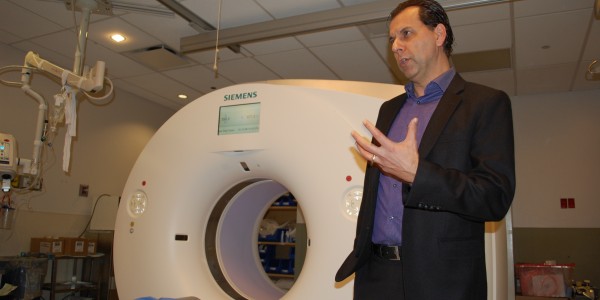A world leader in emergency trauma radiology
This week marks the fifteenth anniversary of the Emergency and Trauma Radiology Division at VGH and the team has a lot to celebrate.
“We are a world-leading program,” says Dr. Savvas Nicolaou, director of the program, which offers CT scans and care, 24/7, 365 days a year. “It’s because of all of the innovation that has taken place within the program – all of the research and the advancement in the acute care imaging setting. We have changed imaging so much that we’re pioneers…trailblazers in the field.”
A first in Canada
VGH was the first hospital in Canada to develop the emergency trauma radiology sub-specialty. Today, the program remains a world leader attracting international attention.
Dr. Nicolaou says program innovations, including one of the first full-body trauma CT protocols in the world (Rapid Imaging Protocol in Trauma – RIPIT ), has led to other institutions around the globe paying close attention to what the program is doing.
“I’m asked to go around the world – to Harvard, to London, to Singapore – to talk about our work and experiences at VGH…what we have done from a chest pain perspective, from a trauma perspective,” he says of the program recently voted as one of the top three emergency trauma radiology programs in the world at the Radiological Society of North America conference held in Chicago this year. “We are definitely world leaders here.”
“This machine is a lifesaver”
Even more cause for celebration is the arrival of a new, state-of-the-art CT scanner in the ED. Dr. Nicolaou says the new machine will save lives and improve patient care.
“The new CT scanner is faster, safer and patient-friendly,” he explains. “Less intravenous dye is required to image the human body, which is good for the patient’s kidneys, and because the scanner works at turbo speed, it can image the heart in motion so patients no longer need medication to lower their heart rate. Operating with radiation doses so low they rival those of plain x-rays, the new scanner also operates at double the shutter speed than a regular CT scanner so patients don’t have to lie still or hold their breath for long periods of time. It improves patient outcomes – I truly, strongly believe that.”
He points at the large, donut-shaped machine.
“This machine is a lifesaver.”
One of the really unique functions of the new scanner is that it can measure the chemical composition of the human body.
“It uses two energy levels instead of one,” says Dr. Nicolau. “Now, we don’t need to do a biopsy or use a needle. We can actually see the chemical composition with this machine, we can look at the uric acid deposits, iron, copper…it’s amazing. It’s going to save so many people’s lives by looking into the human body. We can now diagnose gout non-invasively without having to stick a needle into the patient.”
Looking at Dr. Nicolaou’s face, it’s clear he is proud to be part of this program.
“I’m ecstatic to be part of this,” he says. “I’m so proud to be part of this program and what we’ve achieved over the past 15 years. I’m truly honoured and privileged to be here at VGH, serving the people of British Columbia.”
Related stories
- VGH first in Canada to offer 24/7 on-site coverage for emergency cardiac CT scans
- VGH ED radiologists make history
- Vancouver General Hospital radiologists help pay for patient-friendly CT scanner

